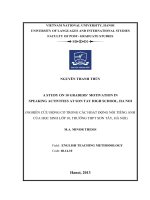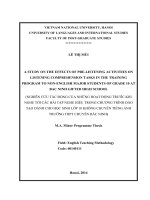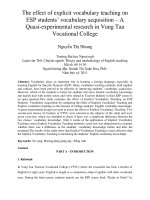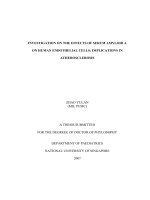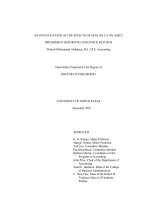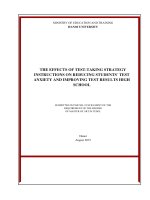The effects of warm up activitives on motivating students to participate in speaking lesson at grade 10 nonmajor students at thuan thanh high school
Bạn đang xem bản rút gọn của tài liệu. Xem và tải ngay bản đầy đủ của tài liệu tại đây (492.34 KB, 78 trang )
TABLE OF CONTENTS
Page
Acknowledgements ............................................................................................ i
Abstract ............................................................................................................ ii
Statement of authorship ................................................................................... iii
Table of contents ............................................................................................. vi
PART ONE: INTRODUCTION
I. Rationale ..................................................................................................... 1
II. Research presupposition ........................................................................... 2
III. Research objectives .................................................................................. 2
IV. Research scope ......................................................................................... 2
V. Research methods ...................................................................................... 2
VI. Significance of the proposed research..................................................... 2
VII. Design of the research work................................................................... 3
PART TWO: DEVELOPMENT
CHAPTER ONE: THEORICAL BACKGROUND
I. Literature review ....................................................................................... 4
II. The nature of speaking ............................................................................ 5
II.1.What is speaking? ............................................................................ 5
II.2. The role of speaking skills .............................................................. 6
II.3. Speaking activities .......................................................................... 7
II.3.1. A successful speaking activity ................................................ 7
II.3.2. Problems with speaking activities ........................................... 8
II.3.3. Principles to teach speaking skills .......................................... 9
III. Factors affecting students’ performance in speaking lessons ............. 10
III.1. Student factors ............................................................................. 11
III.1.1. Students’ learning styles ..................................................... 11
III.1.2. Students’ motivation ........................................................... 11
III.1.3. Students’ language levels ................................................... 12
III.2. Teacher factors ............................................................................ 13
III.2.1. Teachers’ teaching methods................................................. 13
III.2.2. Teachers’ knowledge .......................................................... 13
III.2.3. Teachers’ instructions ......................................................... 14
III.3.External factors ........................................................................... 15
III.3.1.Time limitations .................................................................. 15
III.3.2. Classroom and materials restraints ...................................... 15
IV. Stages of a speaking lesson .................................................................... 15
IV.1. Warm-up .................................................................................... 16
IV.2. Introduction ................................................................................. 17
IV.3. Presentation ................................................................................. 18
IV.4. Practice........................................................................................ 18
IV.5. Review ........................................................................................ 19
V. Warm up .................................................................................................. 19
V.1. Definition of warm up activities ................................................... 19
V.2. The importance of warm up .......................................................... 19
V.3. The functions of warm up stage. ................................................... 20
V.4. Principles of using warm up activities in speaking class in high
school .......................................................................................... 20
V.5. The need of using warm up activities in speaking class ................ 22
V.6. Some common activities used in warm up stage in class ............... 24
V.6.1. Music ................................................................................... 24
V.6.1.1. Ways to use music in classroom ........................... 24
V.6.1.1.1. Set the scene: .............................................. 24
V.6.1.1.2. Change the tempo ....................................... 24
V.6.1.1.3. Musical drawings ........................................ 24
V.6.1.2. Tips for using music in classroom ........................ 25
V.6.1.2.1.Time limits ................................................... 25
V.6.1.2.2. Feelings of students ..................................... 25
V.6.1.2.3. Trying to use music which students like as
much as possible ........................................................ 2
V.6.2. Games ................................................................................ 25
V.6.2.1. Tips for using games ............................................ 26
V.6.2.1.1. Well- prepared .............................................. 2
V.6.2.1.2. Easy to play .................................................. 2
V.6.2.1.3. Time limits .................................................. 26
V.6.3.Story .................................................................................... 27
V.6.3.1. Reasons for using story ........................................ 27
V.6.3.1.1. Stories are very motivating, challenging and
great fun for students. ............................................. 27
V.6.3.1.2. Students can share social experience when
they listen to stories in class. .................................. 27
V.6.3.1.3. Students exercise their imagination through
stories ................................................................... 28
V.6.3.1.4. Stories also “develop the different types of
‘intelligences’ that contribute to language learning,
including emotional intelligence”. ......................... 28
V.6.3.2. Sources of stories ................................................. 28
V.6.3.2.1. Experiences ............................................... 28
V.6.3.2.2.Folktales ..................................................... 28
V.6.3.2.3. Books ......................................................... 28
V.6.3.3. Tips for using story ................................................ 2
V.6.3.3.1. Short and simple story. ................................. 29
V.6.3.3.2. Using pictures or a short video extract to
illustrate the topic .................................................. 29
V.6.3.3.3. Deciding what words to choose and how to
move body and use voice for expression .............. 29
V.6.4. Interview questions .............................................................. 29
V.6.4.1. Tips for using interview questions ........................ 29
V.6.4.1.1. Simple questions. .............................................. 29
V.6.4.1.2. Number questions and participants limits .......... 30
VI. Overview of action research ................................................................ 30
VI.1. What is action research? ............................................................. 30
VI.2. How does a teacher carry out action research in a language
classroom? ................................................................................... 31
VI.3. Summary .................................................................................... 33
CHAPTER TWO: METHODOLOGY
I. Pre – Improvement stage......................................................................... 34
I.1.Step 1: Identifying the problem ............................................................. 34
I.1.1. Identifying the problem ............................................................... 34
I.1.1.1.Description of the participants of the study ......................... 34
I.1.1.1.1 The students ............................................................... 34
I.1.1.1.2. The teacher ............................................................... 34
I.1.1.1.3. The textbook ............................................................. 35
I.1.2. Observing a lesson that illustrated the problem ........................... 35
I.1.3. Conducting a survey to get information from students ................ 35
I. 2. Step 2: Finding causes of the problem ................................................. 37
I.2.1. Consulting with colleagues ......................................................... 37
I.2.2. Reading professional books or journals for ideas and suggestions42
II. Try – out stage ......................................................................................... 42
II.1. Step 3: Designing strategies for improvement .................................... 42
II.2. Step 4: Trying out strategies and making notes on what happened in
the class ......................................................................................................... 43
II.2.1. Teaching Plan .......................................................................... 43
II.2.2. Students’ reports ....................................................................... 44
III. Post – Improvement ............................................................................... 44
III.1. Step 5: Evaluating the try – out ......................................................... 44
III.1. Post – improvement class observation ......................................... 44
III.2. Post – improvement questionnaire for students ............................ 46
III.3. Summary ..................................................................................... 50
PART THREE: CONCLUSION
I. Summary of the main findings ................................................................. 51
II. Implications for more effective writing lessons ..................................... 51
II.1. To the teachers .............................................................................. 51
II.2. To the classroom facilities ............................................................ 52
III. Limitations and suggestions for further study ..................................... 52
IV. Conclusion .............................................................................................. 53
REFERENCES ............................................................................................ 54
APPENDICES .............................................................................................. 56
ACKNOWLEDGEMENTS
This thesis could not have been completed without the help,
encouragement and support of a number of people who all deserve my sincere
gratitude and appreciation.
First of all, I would like to express my deepest gratitude to Mrs. Nguyen
Thi Phuong Lan, my respectful supervisor, who has given me the great help to
my study.
I am also very grateful to teachers of English at English Department of
Thuan Thanh 3 High School, Bac Ninh, who have been willing to answer my
questions and have given me invaluable advice and suggestions on the research
of how warm up activities affect to students’ speaking performance and on the
completion of my research.
I also owe my sincere thanks to all of the students of the classes 10A9 of
Thuan Thanh 3 High School, who have been the enthusiastic participants in my
action research. Without them, my action research could not been completed and
successful.
I would like to send my thanks to my lecturers, my friends and my
classmates for their sincere comments and criticism
In the end, I would like to show my big gratitude to my beloved people,
my husband and my parents, who have constantly inspired and encouraged me
to overcome difficulties to complete this study.
Finally, a special word of thanks goes to my readers for their interest and
comments on this study.
i
ABSTRACT
Warm up activities in language class has been discussed for a long time
and are still on debate. Speaking skills are on the same boat. It is one of the most
outstanding topics in methodology and is a controversial topic as well.
Acknowledge this fact and the importance of two above aspects, the thesis with
the title “The effects of warm up activities on motivating students to
participate in speaking lesson at grade 10 non-major students at Thuan
Thanh 3 High School” has been done with hope to have a small contribution to
language teaching method and to provide some useful know ledges about them.
It is hard for the author to deal with everything about them but hopefully,
the thesis has introduced something new, creative and advantageous for foreign
language teaching
ii
STATEMENT OF AUTHORSHIP
Title: THE EFFECTS OF WARM UP ACTIVITIES ON MOTIVATING
STUDENTS TO PARTICIPATE
IN SPEAKING LESSON AT GRADE 10 NON-
MAJOR STUDENTS AT THUAN THANH 3 HIGH SCHOOL.
I certify that no part of this report has been copied and reproduced by me
from any other person’s work without acknowledgements and the report is
originally written by me under strict guidance from my supervisor.
Data submitted: May, 2013
Student
Supervisor
NGUYEN THI QUY
NGUYEN THI PHUONG LAN
iii
TABLE OF CONTENTS
Page
Acknowledgements ............................................................................................ i
Abstract ............................................................................................................ ii
Statement of authorship ................................................................................... iii
Table of contents ............................................................................................. vi
PART ONE: INTRODUCTION
I. Rationale ..................................................................................................... 1
II. Research presupposition ........................................................................... 2
III. Research objectives .................................................................................. 2
IV. Research scope ......................................................................................... 2
V. Research methods ...................................................................................... 2
VI. Significance of the proposed research..................................................... 2
VII. Design of the research work................................................................... 3
PART TWO: DEVELOPMENT
CHAPTER ONE: THEORICAL BACKGROUND
I. Literature review ....................................................................................... 4
II. The nature of speaking ............................................................................ 5
iv
II.1.What is speaking? ............................................................................ 5
II.2. The role of speaking skills .............................................................. 6
II.3. Speaking activities .......................................................................... 7
II.3.1. A successful speaking activity ................................................ 7
II.3.2. Problems with speaking activities ........................................... 8
II.3.3. Principles to teach speaking skills .......................................... 9
III. Factors affecting students’ performance in speaking lessons ............. 10
III.1. Student factors ............................................................................. 11
III.1.1. Students’ learning styles ..................................................... 11
III.1.2. Students’ motivation ........................................................... 11
III.1.3. Students’ language levels ................................................... 12
III.2. Teacher factors ............................................................................ 13
III.2.1. Teachers’ teaching methods................................................. 13
III.2.2. Teachers’ knowledge .......................................................... 13
III.2.3. Teachers’ instructions ......................................................... 14
III.3.External factors ........................................................................... 15
III.3.1.Time limitations .................................................................. 15
III.3.2. Classroom and materials restraints ...................................... 15
IV. Stages of a speaking lesson .................................................................... 15
IV.1. Warm-up .................................................................................... 16
IV.2. Introduction ................................................................................. 17
v
IV.4. Practice........................................................................................ 18
IV.5. Review ........................................................................................ 19
V. Warm up .................................................................................................. 19
V.1. Definition of warm up activities ................................................... 19
V.2. The importance of warm up .......................................................... 19
V.3. The functions of warm up stage. ................................................... 20
V.4. Principles of using warm up activities in speaking class in high
school .......................................................................................... 20
V.5. The need of using warm up activities in speaking class ................ 22
V.6. Some common activities used in warm up stage in class ............... 24
V.6.1. Music ................................................................................... 24
V.6.1.1. Ways to use music in classroom ........................... 24
V.6.1.1.1. Set the scene: .............................................. 24
V.6.1.1.2. Change the tempo ....................................... 24
V.6.1.1.3. Musical drawings ........................................ 24
V.6.1.2. Tips for using music in classroom ........................ 25
V.6.1.2.1.Time limits ................................................... 25
V.6.1.2.2. Feelings of students ..................................... 25
V.6.1.2.3. Trying to use music which students like as
much as possible ........................................................ 2
V.6.2. Games ................................................................................ 25
V.6.2.1. Tips for using games ............................................ 26
V.6.2.1.1. Well- prepared .............................................. 2
vi
V.6.2.1.2. Easy to play .................................................. 2
V.6.2.1.3. Time limits .................................................. 26
V.6.3.Story .................................................................................... 27
V.6.3.1. Reasons for using story ........................................ 27
V.6.3.1.1. Stories are very motivating, challenging and
great fun for students. ............................................. 27
V.6.3.1.2. Students can share social experience when
they listen to stories in class. .................................. 27
V.6.3.1.3. Students exercise their imagination through
stories ................................................................... 28
V.6.3.1.4. Stories also “develop the different types of
‘intelligences’ that contribute to language learning,
including emotional intelligence”. ......................... 28
V.6.3.2. Sources of stories ................................................. 28
V.6.3.2.1. Experiences ............................................... 28
V.6.3.2.2.Folktales ..................................................... 28
V.6.3.2.3. Books ......................................................... 28
V.6.3.3. Tips for using story ................................................ 2
V.6.3.3.1. Short and simple story. ................................. 29
V.6.3.3.2. Using pictures or a short video extract to
illustrate the topic .................................................. 29
V.6.3.3.3. Deciding what words to choose and how to
move body and use voice for expression .............. 29
vii
V.6.4. Interview questions .............................................................. 29
V.6.4.1. Tips for using interview questions ........................ 29
V.6.4.1.1. Simple questions. .............................................. 29
V.6.4.1.2. Number questions and participants limits .......... 30
VI. Overview of action research ................................................................ 30
VI.1. What is action research? ............................................................. 30
VI.2. How does a teacher carry out action research in a language
classroom? ................................................................................... 31
VI.3. Summary .................................................................................... 33
CHAPTER TWO: METHODOLOGY
I. Pre – Improvement stage......................................................................... 34
I.1.Step 1: Identifying the problem ............................................................. 34
I.1.1. Identifying the problem ............................................................... 34
I.1.1.1.Description of the participants of the study ......................... 34
I.1.1.1.1 The students ............................................................... 34
I.1.1.1.2. The teacher ............................................................... 34
I.1.1.1.3. The textbook ............................................................. 35
I.1.2. Observing a lesson that illustrated the problem ........................... 35
I.1.3. Conducting a survey to get information from students ................ 35
I. 2. Step 2: Finding causes of the problem ................................................. 37
I.2.1. Consulting with colleagues ......................................................... 37
I.2.2. Reading professional books or journals for ideas and suggestions42
viii
II. Try – out stage ......................................................................................... 42
II.1. Step 3: Designing strategies for improvement .................................... 42
II.2. Step 4: Trying out strategies and making notes on what happened in
the class ......................................................................................................... 43
II.2.1. Teaching Plan .......................................................................... 43
II.2.2. Students’ reports ....................................................................... 44
III. Post – Improvement ............................................................................... 44
III.1. Step 5: Evaluating the try – out ......................................................... 44
III.1. Post – improvement class observation ......................................... 44
III.2. Post – improvement questionnaire for students ............................ 46
III.3. Summary ..................................................................................... 50
PART THREE: CONCLUSION
I. Summary of the main findings ................................................................. 51
II. Implications for more effective writing lessons ..................................... 51
II.1. To the teachers .............................................................................. 51
II.2. To the classroom facilities ............................................................ 52
III. Limitations and suggestions for further study ..................................... 52
IV. Conclusion .............................................................................................. 53
REFERENCES ............................................................................................ 54
APPENDICES .............................................................................................. 56
ix
PART ONE
INTRODUCTION
I. Rationale
At present, English is a compulsory subject in high schools. The
textbook’s contents are quite good because it consists of four basic skills such as
reading, speaking, writing and listening. It not only helps students learn
grammar structures, new words but also practices English immediately.
In fact, there are 6 high schools in my Thuan Thanh district. All students
in these schools are taught the same textbook and examed the same tests. These
tests are only written tests not oral tests. Therefore, most students focus on
learning grammar structures and new words but ignore speaking. As discussion
with non-majored students in these high schools about why students have 9
years to learn English but their ability to speak English is very limitation. They
consider the first reason is that most teachers start a speaking lesson by checking
homework which causes students nervous. Then instead of applying some
activities to raise students’ interest, teachers go straight on a new lesson.
Sometimes, teachers’ guides are not clear enough for students to understand, so
they say nothing in speaking lesson. It’s time for them to do other works. For
long time, students have lost their chances to speak and felt ashamed when
speaking. According to some teachers, they have applied some activities at the
beginning of speaking lessons but time for warm up stage is short, only 5
minutes, however, in 5 minutes they have to check homework as well as do
activities so they have not used activities effectively, or sometimes no activities.
I am totally disappointed with this fact in my district. So in my research, I
would like to give some activities used in warm up stage of speaking lesson and
some useful tips to apply them effectively in order to raise students’ interest and
enhance the effectiveness of speaking lessons in Thuan Thanh 3 High School.
1
II. Research presupposition
With regard to suggest some useful activities used in warm up stage in
speaking lessons, some questions are raised:
- Do teachers highly appreciate the warm up activities in a speaking
lesson?
- How do warm up activities affect the students’ speaking performance?
III. Research objectives
Giving activities which can be used in warm up stage in order to enhance
effectiveness of the speaking lesson and students’ interest
IV. Research scope
The study focus on activities used in warm up stage and how to apply
these effectively in speaking lesson
The population involved 50 students in grade 10 and 15 teachers of
English in Thuan Thanh 3 High School
V. Research methods
To achieve the objectives of the study, the following methods have been
applied:
- Action research is the first method used in this study.
- Questionnaire surveys are the second method used in this study. The
analysis is mainly based on the data collected through the survey questionnaires
Besides, the consultation with the supervisor and discussion with friends
are also the main supporting methods
VI. Significance of the proposed research
Speaking, one of the two productive skills has always a significant
position in language teaching. Nevertheless, how to teach and learn speaking
effectively often poses great problems to both teachers and students. For the
2
teachers of English at high school, speaking is considered a difficult skill to
teach. Some of them even ignore teaching speaking skill and focus only on
grammar exercises for the exams. However, nothing is difficult if we, the
teachers make decision to make it easier. Hopefully, with a range of suggestions
of how to make warm up activities effectively in speaking lessons introduced in
this research, it will be more motivating for the teachers to teach and make
progress in teaching speaking. Therefore, their students will be interested in
speaking lessons.
VII. Design of the research work
The research consists of three parts:
Part I entitled “Introduction” outlines the background of the research. In
this part, information about the rationale, presupposition, objectives, scope,
methods, design and significance of the proposed research are provided.
Part II with the title “Development” comprises 3 chapters:
Chapter 1 entitled “The Theoretical Background” provides all necessary
information related to speaking skills, speaking activities, warm up activities and
action research
Chapter 2 is about the “Action Research Procedure” which shows the
steps to conduct the research at Thuan Thanh 3 High School in Bac Ninh.
Part III is the “Conclusion” which gives a brief overview on the
achievement of the thesis and suggests some extensive topics relating to the
thesis.
“Reference” is coming next with a list of sources of materials are
presented in detail.
The thesis ends with “Appendix” part in which the questionnaires of the
surveys are also given.
3
PART TWO
DEVELOPMENT
CHAPTER ONE: THEORICAL BACKGROUND
I.
Literature review
Activities for speaking class are a topic which has been interested and studied
by a lot of writers. In “ Warm up activities for speaking class in high school”,
Nguyen Thi Van Lam, M.A. (2005) confirms that speaking skill is one of the
most outstanding topics in methodology and is a controversial topic as well. Her
thesis mentioned to things related to warm up activities in general; all necessary
theoretical concepts concerned with the topic such as the Communicative
Approach (C.A), the nature of speaking and warm up activities; especially, some
useful activities used in warm up stage in speaking lessons.
In “Games to teach”, Diana Mungai, Dianne Jones and Lorna Wong (2005)
considered that the use of games that teach can be traced back many thousands
of years. The goals of the article are the theoretical foundations behind the use
of games in teaching and training in both college and corporate settings, various
uses of games in learning, tools and techniques that help bridge the gap between
experiencing the game and tying it to the learning objectives and the value of
games as tools that support different learning styles.
Veronika Rosova (2007) deals with the use of music in teaching English. The
attention is paid to songs, mainly focusing on their importance in language
teaching both from theoretical and practical point of view. It is supported by the
research that main subject of which is to find out if music helps to acquire and
remember vocabulary.
And Carol Read (2010) defines that stories are central to our lives. For this
reason, the author also believes that it is vital to create a ‘narrative sensibility’ in
children in their own language(s) through giving them access to and familiarity
4
with conventional stories, myths, fables, histories, fairy tales and folk tales that
are part of their own culture(s). It is these stories combined with the child’s
evolving powers of comprehension, analysis, discussion and imagination that
can play an instrumental role in developing children’s sense of who they are.
In fact, there have been many people writing about warm up activities and
some graduation thesises about these as well. However, these materials are too
general and difficult to apply in Vietnam. Moreover, teachers and students in
high schools, actually, are not aware much about the importance of warm up
activities. These problems have been tossed in the sleep of the author. So the
thesis with the title “The effects of warm up activities on motivating students to
participate in speaking lesson at grade 10 non-major students at Thuan Thanh 3
High School” has been conducted.
II. The nature of speaking
II.1. What is speaking?
Speaking is an interactive process of constructing meaning that involves
producing and receiving and processing information (Brown, 1994, Burn and
Joyce, 1997). Its form and meaning are dependent on the context in which it
occurs, including the participants themselves, their collective experiences, the
physical environment and the purposes for speaking.
It is often spontaneous, open-ended and evolving. However, speech is not
always unpredictable. Language functions that tend to recur in certain discourses
situations can be identified and charted (Burn and Joyce, 1997). Speaking
requires that learners not only know how to produce specific points of language
such as grammar, pronunciation, or vocabulary but also those they understand
why, when, and in what ways to produce language.
Finally, speech has its own skills, structures and conventions different
from written language.
5
II.2. The role of speaking skills
Of all four language skills, speaking seems intuitively the most important:
people who know a language are referred as “speaker” of that language as if
speaking included all others kind of knowing and many if not most foreign
language learners are primarily interested in learning to speak. The people who
are good at speaking are ones who master not only grammar, pronunciation,
intonation, vocabulary but also the social contexts in which language is used. In
other words, speaking, in real sense, included both producing language and
applying it in different circumstances in life. In short, in methodological sense,
speaking skills are closely related to all other language skills.
Nowadays, English is the international language, so the ability of using
English in communication is very necessary. Admittedly, speaking is the fastest
way to exchange information; therefore, more and more people are trying to
learn English speaking skills on the purpose of communicating in the modern
world. This tendency puts speaking in the highest position among all four
language skills.
It cannot be denied that speaking has its own outstanding forces. The fact
is that besides speaking, writing, a productive skill, is also a very useful device
in social communication. However, it is quite different from speaking which is a
spontaneous activity and we have to spend less time on preparing the content of
a speech than composing an essay.
In biological sense, talking is the first ability that one person possesses.
This also helps us be sure that producing an utterance is easier than giving a
composition.
What is more, when we speak, we not only produce language items but
also express our attitude by using body language such as facial expression,
gestures,... and by the rhythm of the utterances. These extral factors contribute
much to the success of an interactional talk. That is the typical force of speaking
that no other skills have. It is this characteristic that makes speaking to be
appreciated higher and higher.
6
Teaching speaking skills, therefore, is forces to be developed much to
meet the demand of learners
II.3. Speaking activities
II.3.1. A successful speaking activity
It is not easy to carry out successful a speaking activity in classroom if we
are not sure about the characteristics of a model of it. There have been many
arguments about what a successful speaking activity is. These following
characteristics are accepted the:
The first characteristic is that learners talk a lot. Teacher should know that
how to get students talk in the target language as much as possible in the time of
the activity is the most important. If most of the class time is taken up with
teacher talk or pauses and very few chances are for students’ talk when carrying
out an activity, it cannot be considered to be successful. Most of the class time is
allotted to the students. Teachers only play the role of guiders, so they should let
students be free to express their understanding in their own ways.
The second one is high motivation. It is one of the most important criteria
to evaluate a speaking activity. How to create high motivation to students in
class and to make the classroom dynamic is the matter that teachers should care
when conducting an activity because it is these factors that lead students to study
effectively. To achieve these, activities used in class must be interesting, they
are in favor of the students, right for students’ interests, and they must be carried
out in group work, pair work or class work. Teacher of English, therefore,
should be more careful and wholehearted when planning lessons.
The third one is even participation. It means that classroom discussion
attracts equal contribution of all students. If class time is dominated by a
minority of talkative participants and no chance of talking is used by the worse
during the time of activities, of course, these cannot be seen as successful
speaking activities. Indeed, uneven participation may badly affect the
improvement of speaking ability of the students because some worse students
have few practices and day by day they may lose their confidence.
7
Last but not least, it is necessary for teachers to remember that language
of speaking activities must be at the acceptable level. In other words, their
language should be relevant to students’ degree, easily comprehensible to
students and of an acceptable level of language accuracy. Obviously, if the
language is too difficult, students will be afraid and pressed when they try to
speak English or they may not enjoy these activities. That is why before
deciding which activity is the suitable one; teachers should pay attention to its
language’s requirement.
I.3.2. Problems with speaking activities
Admittedly, it is quite difficult to talk in the target language even though
you are the teachers of foreign languages, how to carry out a speaking activity as
well as to get students involved in them is the concern of teachers when teaching
English as a second language.
There are many problems in teaching and learning English speaking skills
faced by teachers and learners. The author is going to discuss some popular ones
with the hope of helping teachers avoid or overcome those.
The first matter is the inhibition feeling of students. Unlike reading,
writing and listening activities, speaking requires some degree of real time
exposure to an audience. Learners are often inhibited about trying to say things
in a foreign language in the classroom: they are worried about making mistakes,
fearful of criticism or losing face, or simply of the attention that their speech
attracts. Teachers should be able to help students to overcome this feeling in the
speaking class.
The second problem that learners may get into is that they have nothing to
say. Even if they are not inhibited but you often hear learners complain that they
cannot think of anything to say, they have no motive to express themselves
beyond the guilty feeling that they should be speaking. This may happen
because of the complex of the topics used or the language of activities which are
above the degree of learners.
8
In speaking class, students sometime use their mother tongue much more
than the target language. That is one problem that teachers should care about. In
classes where all, or a number of, the learners share the same mother tongue,
they may tend to use it because it is easier and because it feels unusual to speak
to one another in a foreign language, and because they feel less “ exposed” if
they are speaking in their mother tongue. If they are working in small groups, it
can be quite difficult to have some classes-particularly; the less disciplined or
less motivated ones keep talking in target language. This is one of the
disadvantages of using group work.
One more difficulty occurs in speaking class that is low or uneven
participation. Only one participant can talk at a time of he or she is be heard, and
only in a large group, this means each one will have only very little talking time.
This problem is compounded by the tendency of some learners to dominate
while others speak very little or not at all. The task of teachers is to monitor the
class time in order to provide chances of talking to all students in the class fairly.
When preparing activities for speaking class, teachers of English should
pay much attention to the above problems, so that the class time will be
successful and useful to students.
II.3.3. Principles to teach speaking skills
How to teach speaking skills the most effectively is a big controversial
topic. Different authors give different opinions about the principles of teaching
speaking skills. It is important to remember that that the goal in language uses is
natural communication, which is why the principles to teach speaking are
divided into groups basing on level of students.
Forseth Et al (1994) presents principles in teaching speaking for the
beginning level (students in high school) as follows:
Teacher should limit the objectives to avoid overwhelming the learners.
Teachers should provide students with enough structure practice so they can
begin interacting at the basic level. This will reduce students’ fear and
encourage more speaking and later, more free production can come after the
9
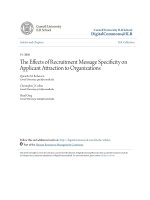
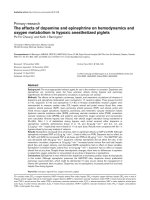
![daniels and booker - 2011 - the effects of audit firm rotation on perceived auditor independence and audit quality [mafr]](https://media.store123doc.com/images/document/2015_01/06/medium_sds1420548148.jpg)
